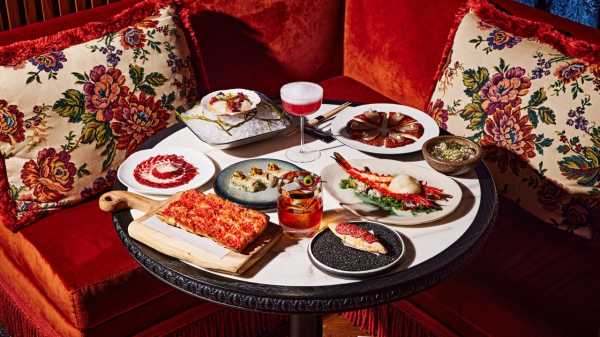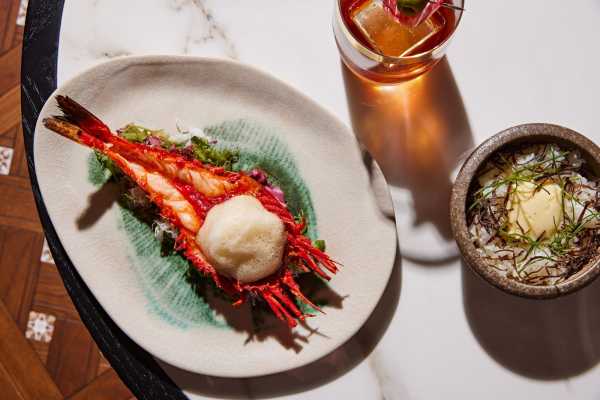
Save this storySave this storySave this storySave this storyYou’re reading the Food Scene newsletter, Helen Rosner’s guide to what, where, and how to eat. Sign up to receive it in your in-box.
The Spanish-born chef José Andrés has, in recent years, been recognized more for his remarkable humanitarian work than for his culinary accomplishments. World Central Kitchen, a nonprofit organization that he founded after the 2010 earthquake in Haiti, nimbly mobilizes field kitchens to feed people around the globe affected by natural and other disasters. When the COVID-19 pandemic ravaged the U.S., Andrés led the conversion of temporarily shuttered restaurants around the nation into takeout soup kitchens. In 2022, he established eight kitchens on the Poland-Ukraine border to feed refugees fleeing the Russian invasion of Ukraine. He is a charismatic, passionate man of obvious integrity and uncommon political engagement. (Naturalized as a U.S. citizen in 2013, he is also a vocal pro-immigration advocate.) On more than one occasion, I’ve heard people joke that Andrés ought to be awarded the Nobel Peace Prize. Then there’s a pause as they realize that maybe it isn’t actually a joke at all.
The Bazaar by José Andrés
35 W. 28th St.
Dishes $14-$65
It’s almost easy to forget that Andrés is also, by any measure, a mega-chef—a prolific author of cookbooks, a winner of countless awards, and the proprietor of a vast empire of dining establishments. His ThinkFoodGroup, headquartered in Washington, D.C., operates some three dozen bars and restaurants in the U.S. and the Caribbean. New York got its first Andrés spot in 2019, with Mercado Little Spain, a wondrous place, part food court and part grocery store, on the ground floor of Hudson Yards. As of this summer, he has added a trio of destinations in the new Ritz-Carlton NoMad, on Twenty-eighth Street, including an outpost of his high-end flagship restaurant, the Bazaar by José Andrés.

Live scallops with tomato, soy ponzu, olive oil, and marinated seaweed.
It feels wrong to call the Bazaar a chain restaurant, but it’s not not a chain. The New York location is Andrés’s sixth establishment under the name; each one is thematically distinct but recognizably part of the brand. Bazaars are theatrical restaurants, with opulent, multilayered décor and maximalist menus featuring showpiece dishes and culinary sleights of hand. Andrés came of age as a cook in the era of molecular gastronomy, when the fine-dining world was enraptured by the whimsy and materials-science bravado of Spanish chefs like Ferran Adrià (with whom Andrés has worked closely, including at Adrià’s legendary late restaurant, El Bulli). The Bazaar’s conceit is, more or less, turn-of-the-millennium culinary modernism grafted onto some second thing: Las Vegas, Los Angeles, and one of the Chicago locations adopt the trappings of a steak house; the D.C. Bazaar brings spheres and foams to classic Americana. With the New York iteration, Andrés has turned his attention to Japan, inspired—as he explains on the restaurant’s menu and, more extensively, in a Substack post published in August, when the restaurant opened—by the seventeenth-century journey of Hasekura Tsunenaga, a Japanese samurai of imperial descent, to the court of Spain, and what culinary chimeras might have emerged from that meeting.
It’s all a little bit ridiculous. If you have a pre-dinner cocktail in the restaurant’s plush, loungey bar, situated on the hotel’s ground floor, you’ll find yourself watched over by a towering portrait of a geisha wearing a Spanish-style comb and mantilla. Upstairs, in the dining room, the visuals are less literal (jewel-toned jacquards, pearly frosted glass—your standard-issue placeless luxury), though you will now contend, instead, with the ways this thematic fusion manifests itself as food. It’s a fundamentally fun, intriguing concept, though the restaurant and its staff seem to be working hard to deflate any shred of amusement. At Andrés’s other restaurants, including the other Bazaars, his chatty, wisecracking voice is all over the menu. On an early version of the New York Bazaar menu, one section header winkingly read “Raw bar, crudos, sashimi . . . same thing.” But now the ellipsis and the final quip are gone. Other section headers emphasize isomorphisms between Spanish and Japanese kitchens: “Plancha/Tepan” (a flat cooking surface), “Josper/Robata” (a coal-fired grill). But it was only by reading that expository Substack post that I learned that the Spanish-seeming dishes were cooked on Japanese equipment and vice versa, a playful switcheroo.

The carabinero with “ponzu air” on a bed of silky-rubbery marinated seaweed.
Playfulness is the most generous lens through which to consider many of the dishes on the menu, which are intricate, kooky, and not always successful. Cotton Candy O-toro is a small pouf of spun sugar on a stick, in the center of which is a morsel of soy-marinated raw tuna and a confetti of crispy rice. The creation is a riff on Andrés’s famous cotton-candy-wrapped foie gras—a brilliant twist on the traditional pairing of the sweet and the fatty. Andrés débuted the dish in the early two-thousands, at his now-closed D.C. restaurant Café Atlántico. Here, run through a Nipponifying algorithm, it becomes total nonsense, with the one-note sugar of cotton candy fighting against the delicate salinity of the fish rather than balancing it. For a bowl of mushroom ramen, the broth is heated tableside in a Japanese coffee siphon, a complexly vertical contraption that looks like lab equipment and is thrillingly, pointlessly dramatic as a vehicle for soup. It’s impossible to take seriously, but if you engaged with it on the level of silly spectacle it could be a delight—if only any of the nervous-seeming servers, lighting the flame and gazing into the roiling liquid with the sombreness of holy monks, looked as if they were allowed to have fun. The less pageantry, it seems, the better the dish: an understated little plate of pressed sushi—precise rectangles of shiso-flecked rice topped with raw shima aji (striped jack) and a dollop of wildly crunchy, spicy salsa of pine nuts, rosemary, and crispy garlic—provided a rare moment of genuine dazzle.
But you don’t go to a José Andrés restaurant for simplicity. In each of my visits to the Bazaar, I found myself drawn to its more over-the-top attractions, and then wishing that there were more confidence, more weirdness, more passion in the nonsense. Japanese ingredients and techniques have become ubiquitous in high-end kitchens of all kinds in recent years, so much of what the Bazaar presents as high-flying acts of fusion feels predictable (dabs of wasabi everywhere), or just falls flat. The “escabeche air” that topped a clutch of plump, raw oysters enticingly resembled sea foam but tasted more like air than like escabeche, and the “green apple ‘pearls’ ” promised within were just tiny spheres of raw apple, one per oyster, a measly hidden treasure. The menu announces that select cuts of Wagyu beef, available by the ounce, can be grilled tableside on a sizzling-hot ishiyaki stone—but when I inquired about a few ounces of precious short rib I learned that the restaurant now prepares it in the kitchen, because some diners had complained that the tableside theatrics were too distracting. Socarrat, the crispy rice at the bottom of a paella, was cleverly repurposed as a crêpe-like base for tender slices of more raw shima aji (again? again), but that’s a mild fish, more texture than flavor, and the gorgeous circle of saffron-infused rice called out for something more vivid, more alive, both more Spanish and more Japanese: the metallic sweetness of botan ebi (Japanese sweet prawns), perhaps, or the basso profundo of smoked pimentón.

The theatricality of the Bazaar extends to its opulent, multilayered décor.
Sure, you can dress a colossal carabinero with “ponzu air” and serve it on a bed of silky-rubbery marinated seaweed, and each element will be delicious (and, really, it had better be, at $64 for a single big shrimp), but there’s a cohesion missing at the new Bazaar, in this dish and elsewhere. The menu—a physically enormous object listing nearly four dozen dishes, not including drinks or dessert—offers a grab bag of ingredients and techniques from complementary culinary cultures rather than a true marriage between them. At times, Andrés’s mastery of Spanish ingredients and flavors overwhelms the menu’s Japanese elements. The most successful creations are the most unabashedly Iberian, such as cracker-like hollow torpedoes of bread filled with an airy whipped Manchego cream. The arrangement nods to Japan with the addition of paper-thin slices of Wagyu beef, but that roiling ocean of nutty, tangy, supersharp cheese, a pure evocation of Spain, would be just as delicious without any meat at all.
I’ve eaten at many José Andrés joints over the years, including the original Bazaar, in Los Angeles, an excellent restaurant that knew how to wield its gimmickry. (Sadly, it closed permanently during the pandemic.) My favorite thing, across the whole Andrésverse, is a cocktail: the Salt Air Margarita, a satiny blend of tequila, orange liqueur, and lime juice, under a dollop of salty foam, like the fading head on a beer. I first encountered the drink a decade ago at China Poblano, Andrés’s dumpling-and-taco parlor in Las Vegas (another, more successful exercise in audacious culinary exchange), and was overjoyed to see it pop up here at home, albeit with a pomegranate twist. Andrés and his team have an uncanny knack for drinks; their love of unexpected infusions and trompe-l’oeil textures are more reliably successful behind the bar than in the kitchen. At the Bazaar, a nonalcoholic concoction called the Firefly was one of the most pleasing zero-proof drinks I’ve had in ages.
Like the food, which seems to be priced for people who have no need to look at prices, the drinks are soberingly expensive, at twenty-five to thirty dollars apiece. A few, made with a pricey mezcal that’s been infused with precious jamón ibérico de bellota, have price tags that can climb to fifty. It seems like a pointless flourish—the star ingredient, to my palate, was undetectable in the Andrés y Cooper, though the drink itself, something like a smoky Negroni, was otherwise excellent. Still, for the price of that one ham-kissed glass, you could get a lordly portion of the actual meat: a leg of jamón ibérico crisscrosses the dining room on a wheeled mahogany cart; flag it down to have a serving sliced tableside, each piece carefully arranged in a spiralling vermillion nautilus, streaked with snowy fat. It’s funky and ferocious, the righteous king of aged hams. Such severe simplicity is, itself, a type of spectacle. Not another thing on the menu is its equal. ♦
Sourse: newyorker.com
